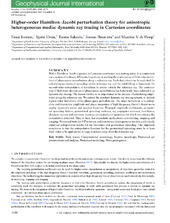Higher-order Hamilton–Jacobi perturbation theory for anisotropic heterogeneous media: dynamic ray tracing in Cartesian coordinates
Peer reviewed, Journal article
Published version

View/
Date
2019Metadata
Show full item recordCollections
- Department of Earth Science [1034]
Original version
https://doi.org/10.1093/gji/ggy533Abstract
With a Hamilton–Jacobi equation in Cartesian coordinates as a starting point, it is common to use a system of ordinary differential equations describing the continuation of first-order derivatives of phase-space perturbations along a reference ray. Such derivatives can be exploited for calculating geometrical spreading on the reference ray and for establishing a framework for second-order extrapolation of traveltime to points outside the reference ray. The continuation of first-order derivatives of phase-space perturbations has historically been referred to as dynamic ray tracing. The reason for this is its importance in the process of calculating amplitudes along the reference ray. We extend the standard dynamic ray-tracing scheme to include higher-order derivatives of the phase-space perturbations. The main motivation is to extrapolate and interpolate amplitude and phase properties of high-frequency Green’s functions to nearby (paraxial) source and receiver locations. Principal amplitude coefficients, geometrical spreading factors, geometrical spreading matrices, ray propagator matrices, traveltimes, slowness vectors and curvature matrices are examples of quantities for which we enhance the computation potential. This, in turn, has immediate applications in modelling, mapping and imaging. Numerical tests for 3-D isotropic and anisotropic heterogeneous models yield clearly improved extrapolation results for the traveltime and geometrical spreading. One important conclusion is that the extrapolation function for the geometrical spreading must be at least third order to be appropriate at large distances away from the reference ray.